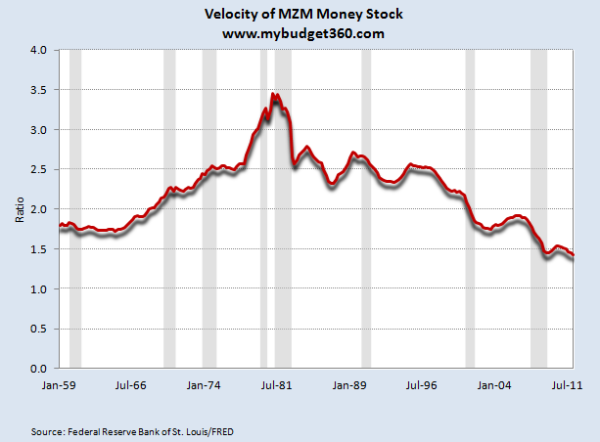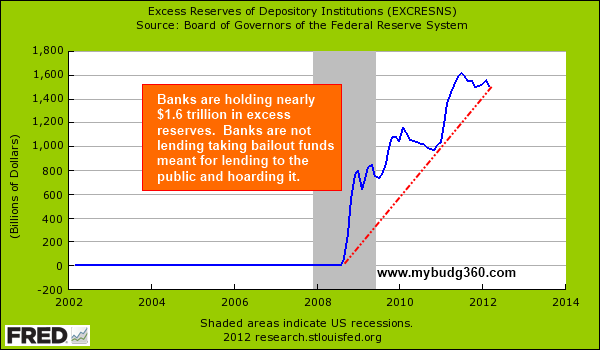- - looking at debt leverage, velocity of money, and contagion impacts from the European crisis
Posted by mybudget360
If you inject money out of thin air into the banking sector
but no quality jobs emerge, is the result a success? The bailout
mission statement revolved around keeping credit available for the
American public. The absolute opposite has occurred. A massive internal credit deleveraging
has been taking place but the banks have simply hoarded the money like a
squirrel hogging all the nuts.
The public is dealing with a great deal
of austerity in the form of higher inflation
in daily good items and an employment market that is extremely
constricted. The issue continues to be that we are treating this crisis
as one of liquidity when it has always been one of solvency. What
function is it giving a bank billions of additional dollars if there are
so few qualified people to lend to?
We even see this restriction of money circulation when we examine the
velocity of money. We are simply injecting more debt into the economy
with decreasing results. Higher energy, food, healthcare, and other
daily goods have risen beyond the average paycheck of most Americans as a consequence.
Chart #1 – Velocity of money
We are getting less bang for each buck that is being injected into
the economy. Sure, we can promise unlimited amounts of debt to the
public but you have to have actual production to back this up. Need we
remind you of the people with $20,000 annual incomes buying $500,000 and $600,000 homes?
Being able to finance your debts is core to our global economy. You
see what happens when this breaks down. Banks are willing to lend in
today’s market but they are now performing due diligence. And guess
what? Not many are qualified to borrow. So the money sits earning
interest for banks while more debt is chasing the same amount of goods.
If simply printing money was a good thing the Fed’s trillion dollar
spending spree would have made this nation much richer instead of bankrupting the middle class through a hidden tax with inflation. If you examine the above chart, the velocity of money has come to a screeching halt yet here we are bailing out banks only so they can give each other multi-million dollar bonuses for essentially passing on bad losses to taxpayers.
Economist Paul Samuelson was quoted as saying:
“In terms of the quantity theory of money, we may say that the velocity of circulation of money does not remain constant. “You can lead a horse to water, but you can’t make him drink.” You can force money on the system in exchange for government bonds, its close money substitute; but you can’t make the money circulate against new goods and new jobs.”
Chart #2 – Excess reserves
Based on the fewer number of qualified borrowers, banks have simply
hoarded the money as seen by the excess reserve chart above. In fact,
banks are willing to take the low Federal Reserve
interest rate instead of injecting it into the economy where consumers
can use the funding. If the goal was to get money into the hands of
consumers, why not just cut a check for $100,000 to each American? As
preposterous as that sounds, it is a better policy compared to giving
banks trillions of dollars in backstops and pretending they were somehow
going to put this back into play for consumers. This leads us to
consumer debt.
Chart #3 – Revolving credit
More @Source

